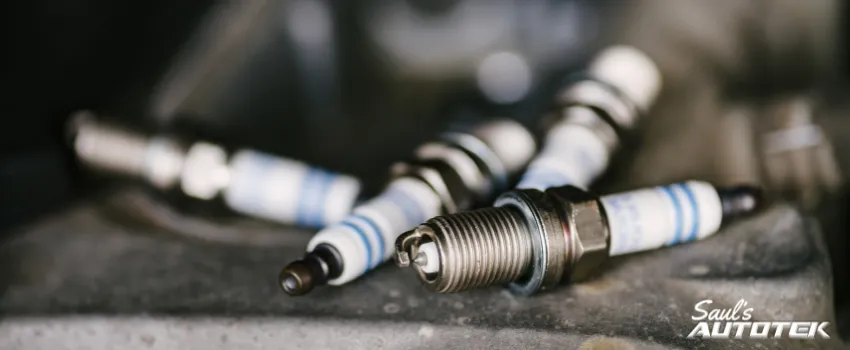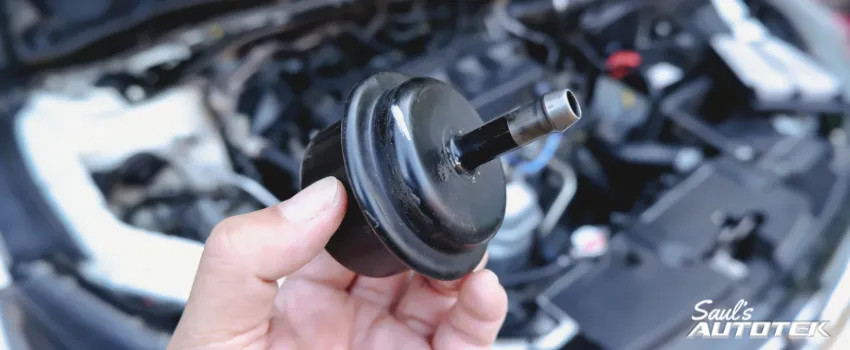Good morning, this is Saul here at Saul’s automotive.
The next components we are going to be looking at in the front end of your vehicle’s steering and suspension is what we call the Pitman and Idler arm.
Read Part Two Of Our Suspension Repair Series Here
In most convention vehicles that are over a half-ton size, meaning any pickup, SUV or larger, about 60 percent of the vehicles on the road in the United States, you have a center-link steering system, meaning that there is one gearbox right where you steer the vehicle straight in front of you on the driver’s rail.
And that one gear pivots everything in the front end to respond accordingly. To keep things even and steering properly side to side, from where this gearbox is located we have a center link about 3 feet wide and then independent rods to both sides to steer both tires.
This way they’re both steered independently so that in the event of a failure of any one of the joints the other tire is still steering and responsive, not leaving you in as dangerous as a situation. That center link itself, because it has to pivot in two directions, has to be mounted to the frame of the vehicle to allow it to tow in and out accordingly.
The way that we mount it to the vehicle is with the Pitman arm and the Idler arm. Now the way that these actually engage on your steering gearbox, there are splines that this arm will slide up on to — is then pressed on with a 5-ton press and then has a very large nut and lock washer to secure it.
This is literally what is holding the steering of your vehicle together. If this joint were to slip or fail the vehicle would lose steering. As a result, this is a splined engagement to prevent such a failure from ever happening.
In addition, many vehicles have a notch in a certain marked location so that this component cannot be installed incorrectly being off a tooth in the rotation which would lead to some serious difficulties on the alignment machine.
On the other end where it physically pivots to the center link, we have a tie rod type joint. This is the same kind of design from your basic tie rod end of a wedged metal fitting, greasable and rotating. The difference in this design is this component is placed fore and aft in the vehicle.
If the vehicle is pointing towards the front, towards the rear, this arm would be parallel to such so that when you steer the vehicle this arm will rotate essentially side to side to push the tie rod ends in and out accordingly to steer the vehicle.
This allows the center link to rotate freely and smoothly without binding. Because this will only work on the driver’s side of the vehicle where the steering gear is mounted, on the passenger side we have what we call the Idler arm, which is exactly as it sounds —
An idler arm. It is not being pulled or pushed on directly. It is simply reactionary. Unlike the Pitman arm which is driven from this spline and uses that motion to push and pull, hence the thickness in girth of this piece, the Idler arm mounts to the frame and acts simply as a sliding pivot.
The center link will mount across it with this tie rod type-fitting and allow it to pivot back and forth. Hence this joint can literally just kind of hang out. As these two joints will move side to side in parallel, they will continue that smooth operation to the steering.
Here’s where things get funky. If both of these joints right here start to wear out and have a little bit of that play of a ball and socket rotating around and can get that motion, rather than that joint moving side to side, it can actually move up and down or fore and aft as well.
What that means is when we’re steering the vehicle if these two joints are wearing out, not only can the steering reverberate side to side and create an oscillatory motion sometimes called death wobble to you jeep guys, this can also allow the center link to instead of riding parallel, perfectly parallel to the ground between these, get kicked unto an angle or pushed out of skew or forward, back in any direction by a minuscule amount —
An eighth of an inch to a quarter of an inch. While that may not seem like much what that translates to is when these components steer side to side to push your steering, because these shoulders are no longer mounted and fixed where they’re pushing, the whole center section can move and rotate.
That translates to you turning the steering wheel let’s say to the left. And instead of pushing straight out to one side and then retracting back to center, the joint will actually lift up, push up and out while pulling the other down.
Instead of having perfectly true steering it binds and squishes itself. When this happens, these outer joints that we were talking about earlier have to work on harder angles than they were designed to.
These were only designed to spin parallel to the ground. if we take this joint and put it on an angle it’s range is significantly reduced. These joints from the factory produce an 18 degree offset at most meaning we must be almost parallel to the ground to keep these functioning properly.
If you have one steering component like your Pitman or Idler arm starting to wear, you need to address it now. Failure to do such will result in other components failing, all of these joints going bad and costing way, way, way more money than you wanted to spend in the first place.
While a single joint replacement can cost less than $100, independent front ends on most pickup trucks have 32 of these joints. We have often seen times where a vehicle comes in and every single joint is destroyed.
At the soonest inclination of any loose play in your steering come and see us. Or if you come and see us for your regular oil changes you know that we check these components because we lubricate them every time your vehicle is in for service.
That way we can guarantee that the longevity of your vehicle is maximized. Last but not least these joints themselves, remember, only have an 18-degree range of motion. Here at Saul’s AUTOTEK we actually fabricate [Inaudible][06:52] ball stud joints that have a 60-degree range of motion.
So for you race car guys, drift drivers and off-road junkies that want to get every inch of steering to go as fast around that corner as possible and let those joints get loose as they can before you really need to replace them, we can upgrade those upgrades here in house.
We can extend the same lifetime guarantees to those suspension components. And we can ensure that you stay on the road with a nice, smooth steering for many years to come. Please let us help keep you safe.
Stop by Saul’s AUTOTEK at any point. Or give us a call at 303-919-7769. We would be happy to take a look at the front end suspension and steering of your vehicle.
Schedule Your FREE diagnostic Subaru Outback Auto Repair Upkeep and Repair Appointment
Check out Our Reviews On Yelp! And Leave A Great One For Us!
Join Our Conversation on Facebook
Explore Our Exceptional Denver Auto Repair Services
- Brake Repair Service
- Suspension Repair
- Steering Repair
- Engine Repair
- Automotive Air Conditioning and Heating Repair





